Contours, 1999
swimming in light.
the body becomes porous.
virtual space infiltrates physical space
and physicality re-shapes the virtual.
contours is a fluid performance environment, enveloping performers, computers, images and audience within a shared ecosystem. It used infra-red cameras, computer vision, and motion analysis to convert the movements of live performers into imagery projected both into the space, and onto the performers themselves. Contours aimed to move beyond the hype surrounding virtual technologies in performance and to create a performance which was genuinely interactive.
During performances, up to 50 audience members at a time climbed onto a custom built, reactive, stage. The stage allowed the audience to follow the performance as the movement progressed from the floor, across the volume, and through to suspension at the top of the space. The movements of the performers were observed by computers and translated into images projected onto the floor, a 360 degree screen and the performers' bodies.
contours moved away from contemporary 'cyber' aesthetics of saturated colors and polygons. It used a minimalist aesthetic to make the technology less obvious and focus the audience's attention on the performance. It rode on the assumption that the borders of bodies are permeable, and that the visual, aural and kinetic senses entwine. When duets occur they are across bodies and liquid light; across senses.
Credits:
contours was created by Susan Kozel (performance), Kirk Woolford, (installation design/programming), Ruth Gibson (performance), Horatio Monteverde (architecture) and Leon Cullinane.Original music was commissioned from Jonny Clark.
Linda Jasper of South East Dance Agency (SEDA) provided invaluable help in administration, promotion and tour management required for the development of the project.
The original contours minisite is located at http://bhaptic.net/bhaptic_old/contours/
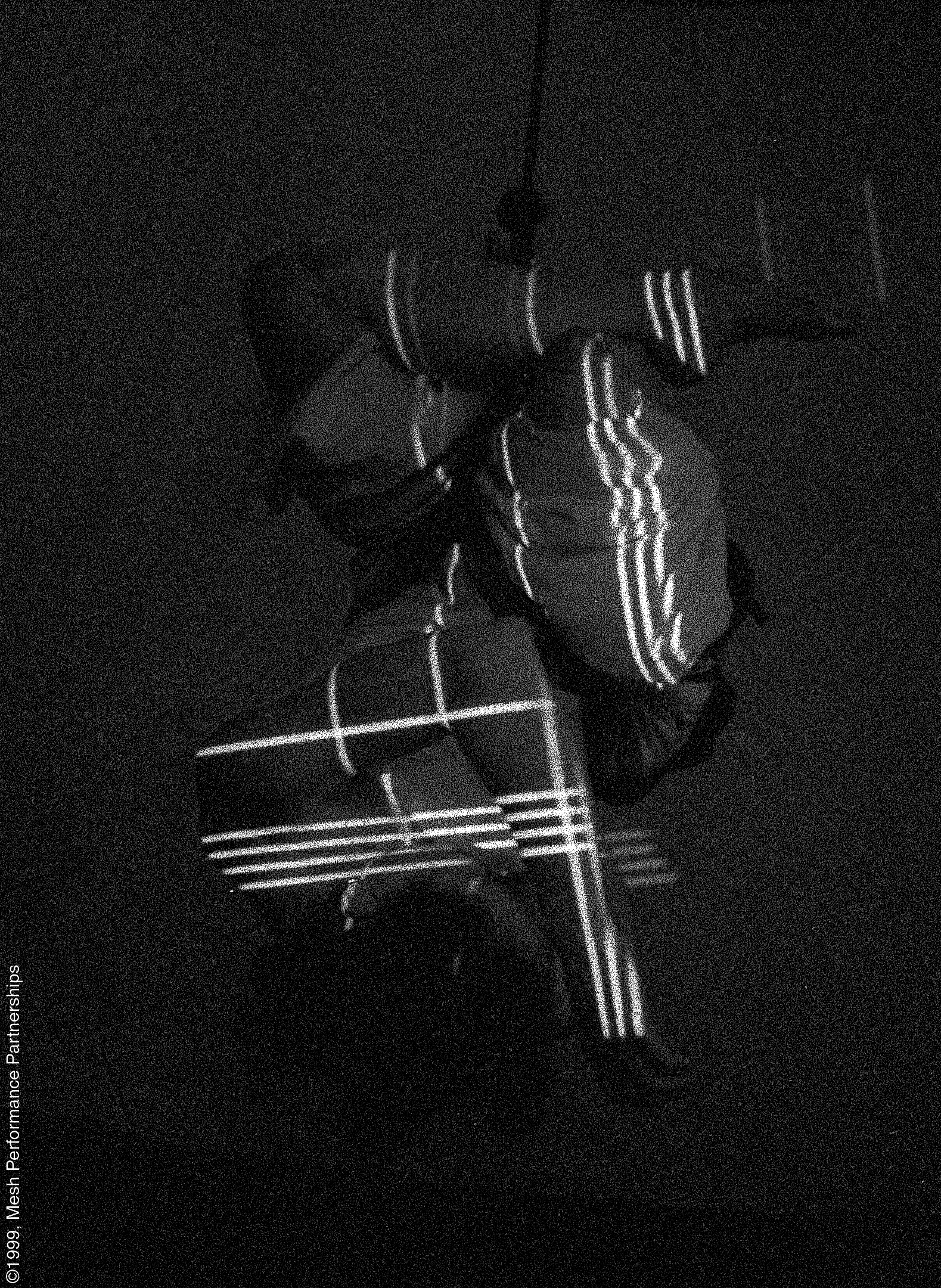

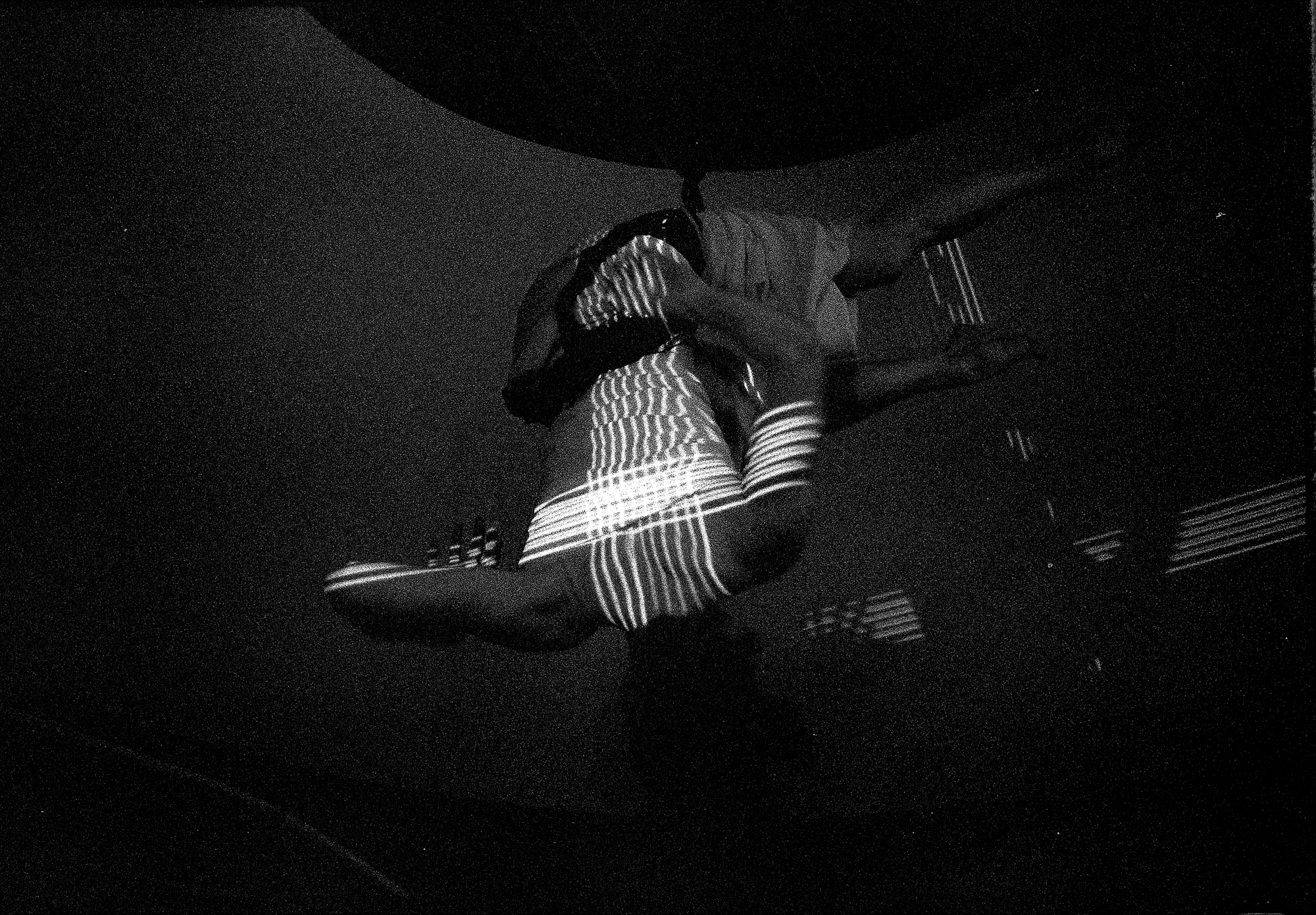
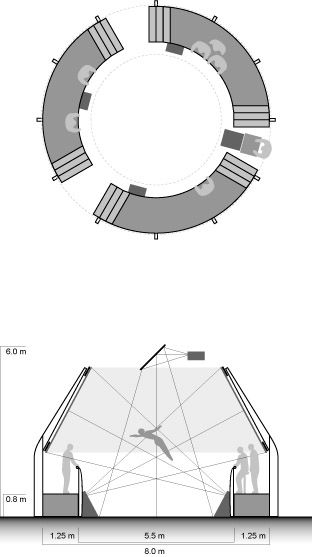
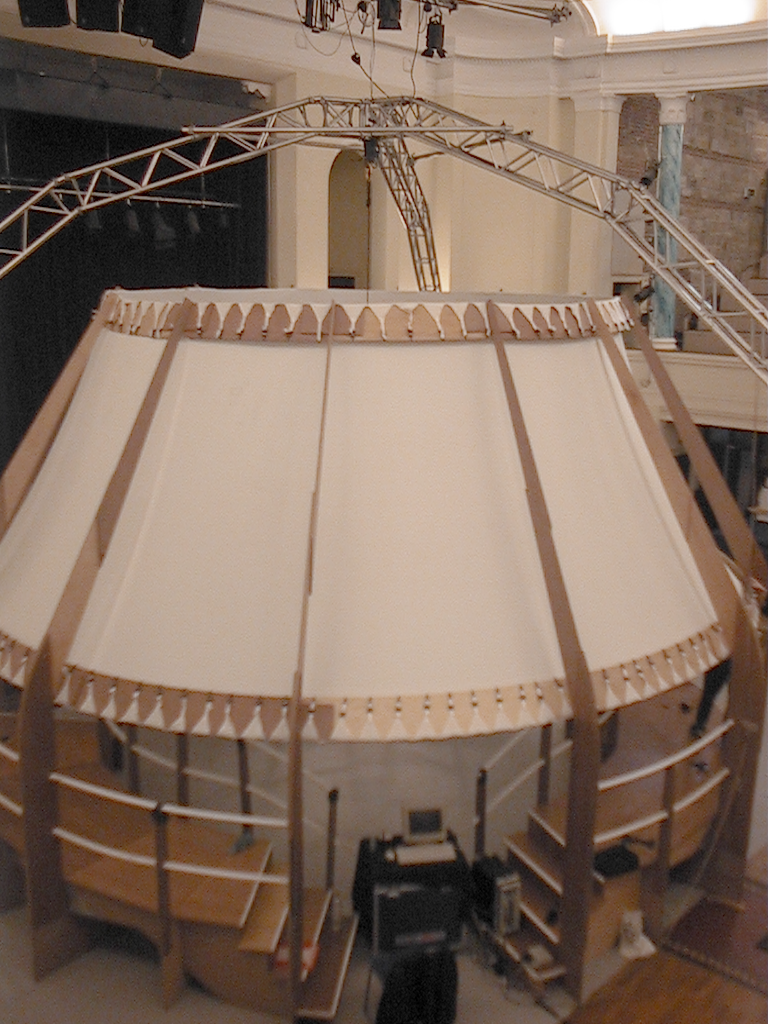
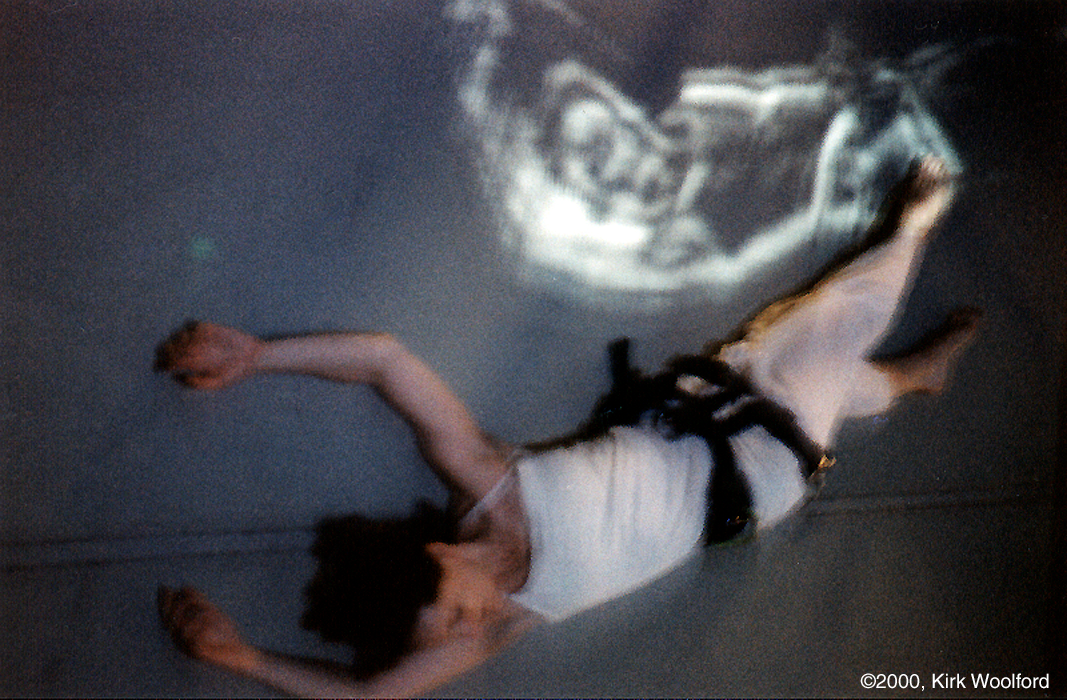
.performance
It is about the dialogue between the imagery and the performers
not the effect of dancers triggering projections.
Without intending to construct a narrative with contours, one emerges around the theme of creation of the self, tension and dissection, finally dissolution into another state. In the development of contours, we didn't select a set of imagery, it emerged as we worked.
The performance travels in three phases from the lower to the upper regions of its space. The interactions of the live performers with their computer-generated "others" follow an interrupted progression of evasion and conjunction, reaction and response across varying degrees of distance.
.one
The movement and imagery begin on the floor, below and surrounded by the audience. The audience sees the performers and projected imagery on the same surface. The computer projects an image of the performer's movements as traces of light similar to ripples in still water. The projected image maps onto the performer's movement, but not necessarily the physical location of her body. The performers catch and loose their own traces. They leap ahead of them, lag behind, shift in dynamic and size. The viewers do not know whether they are watching one person or several.
The movement vocabulary is based around either flicking the surface of a still lake or letting limbs swim as though through the depths, air creating the resistance of liquid. The performer's gaze becomes one of looking up from the floor of the sea through ripples of light, seaweed and water. Movement begins with fingertips appearing and disappearing as the dancers move and stops. It gives a stong feel of creating the body, identity. It becomes an odd sort of duet between the dancer and the appearing and disappearing figure.
.two
The second section is not as luxuriant. One performer departs, projectors illuminate the volume: the floor, and walls of the space. The remaining performer raises herself upright in a climbing harness -- feet just skimming the floor. The computer produces particle systems that respond to the dynamic impulses of the dancer by exploding into clouds, then quieting into a single stream when the motion subsides. The aquatic metaphor shifts to one of circling a cold pool with trepidation then slipping, loosing footing, tumbling down the rocky slope and into the tide
The harness is used in a different way: not the predictable flying or virtuosic circus movement, but slightly awkward shifts of gravity and spills. Limbs are pulled in many directions at once. Her centre of gravity is ripped from one location and thrown outwards, tossed. Turbulent -- a section for being ill at ease within one's trajectories.
.three
The performance space is extended upwards by degrees as the performer is raised in her harness. Suspended within the circle of the screen, above the circle of the audience's eyes. The projections are directed at her body, sending a grid of vertical and horizontal lines onto her and spilling over into the space. The 3-D of her body is flattened by the 2-D of the projected grid as it bends and twists around her body while she gently curls and uncurls. The software performs basic surveillance tasks of identifying what moves (a hand, a head) and projecting the image onto that physical spot. The software attempts to anticipate the direction of movement, so if the dancer's arm begins far left and moves to the right the computer spills projections out that way. If the dancer stops and sends her arm somewhere else there is a moment of confusion. If she holds still the grids slow then flicker out.
The movement dialogue is one of evasion rather than entrapment. It becomes a tense situation of who is orchestrating what: is the dancer controlling the imagery, or is it predicting her movement and causing her to respond. The performer's spirals on unfamiliar axes. The projected grids dissolve the boundaries of her body, making physical form bleed into space, breaking the linearity of the grids, and drawing the movement outwards. A narrative of subtle slippages leads the dancers body into a materiality which dissolves into space. A becoming porous.
.interaction
There is no pre-recorded imagery.
Everything is live -- created by the movements of the dancers and the shape of their bodies in space.
contours draws its name from the way it uses the shapes and contours of moving bodies to generate imagery. It is fully reactive and interactive. The performance space responds to the movements of the performers. At the same time, the performers find their movements influenced by response of the imagery.
It uses infra-red cameras pointed at the dancers from different positions and locations. The cameras are connected to a computer that analyses the video signals and creates imagery by interpreting the video signal and movement in different ways. The software was written by Kirk Woolford, either specifically for the performance or modified as the choreography developed. It is designed to be used as an instrument. During performances, the software is 'played'. Its sensitivity and responses are changed as the performers change their forms of movement.
The performance is broken into sections using varying amounts of motion analysis and abstraction. In the first section, the computer draws traces of whatever it sees moving. The second section moves pixel "snow" across the stage with the speed and shape of the dancers. The final section projects a grid on the part of the dancer's body moving most aggressively.
.one
The computers trace whatever they see moving. There is a direct connection between the movements and the imagery created. When a hand moves, it creates an outline of itself, when it stops, it disappears. At times, random snow appears in the space. The performers cast shadows of both mass and movement.
This section displays the basic technique used by the software in all three sections. It is the most basic form of computer vision. The computer grabs an image from an overhead camera, waits a fraction of a second, grabs another image, and subtracts the first from the second. The leftover image shows what has changed in the time between the images, i.e., what moved. The faster the movement, the greater the change. These changes or 'difference lines' are enhanced by increasing the contrast, brightness, etc, and projected into the space. The person controlling the computer is able to move this image around the space, freeze the image, and create various forms of noise or feedback.
.two
The screen around the audience awakens. A particle stream of flows smoothly across the floor and the screens. Once the performer moves, she breaks the smooth flow of particles. They fly off in the direction and speed of the her movement – only settling into the continuous stream once she slows.
The overhead camera is used to track the performer’s movement across the plane of the floor. The computer divides the floor into a series of lines. The person on the computer sets a movement threshold. As long as the speed of the performers movements remain below the threhold, the particles flow in a set stream across the middle of the space. Once the performers creates a movement greater than the threshold level, a particle is released on the same line and with the same speed as the movmement. There are a finite number of particles, so the performer in the space can conserve them, or send them flying across the space as they desire. The performer behind the computer can lock, or reverse the particles – jarring the audience as the movement of the space and performer slip out of synch.
.three
The performer climbs above the eye-level of the audience. The projection on the floor is shut off, and the hanging body is lit from three sides. Her shadow shows cross-sections on each of the screens. Lines dissect her body, then settle down. Once she moves, the lines re-appear on the moving body part. When she stops moving, the lines flicker out.
The computer is switched from the overhead camera to a camera at floor-level. The software breaks the incoming image into X and Y lines and looks for changes in the image across these lines. It calculates compound change, or movement, for each line, determines the 5 greatest regions of change on X and Y lines. If the changes are greater than the threshold set by the performer at the computer, the computer caculates a direction vector based on previous and current movement region, and projects a line between past and current movements. This allows a more fluid tracking, opening, closing, and drifting. The threshold sensitivity is continually changed to allow movements to be caught, followed, and released.
.one.one.one.one.on…
Because the cameras and projectors are pointed at the same surfaces, feedback becomes an extremely important issue in both the space and the environment. In the first section, the space can be set in careful balance so any movement will trigger a feedback loop which repeats the movement slightly offset in time until it is carried out of the performance space. In the third section, feedback is used to temper the ferocity of the tracking. When the system locks, and tracks perfectly, it is a poor performance partner. It is too predictable. It follows the live performer – never leading her in any direction. By adding and removing feedback, the performer’s movements are returned in a slightly different form, giving the performer, and the audience a new contour to shape, to explore.
.credits:
contours is an international co-commission of: the University of Surrey's Choreographic Laboratory (Guildford, England), south east dance agency (Brighton, England), SK Culture Foundation, Cologne, Academy of Media Arts, (Cologne, Germany), Dance Department of the Cologne Academy of Music together with the Ministry of School and Science of the land North Rhine-Westphalia (Cologne, Germany)
Production and touring have been supported by the Arts Council of England, South East Arts, the Ministry of School and Science of the land North Rhine-Westphalia (Cologne, Germany), and the SK Culture Foundation (Cologne, Germany)
contours is created by:
Concept: Susan Kozel, Kirk Woolford
Performance and devising: Susan Kozel, Ruth Gibson
Installation design: Horacio Monteverde, Kirk Woolford
Installation construction: Leon Cullinane
Software: Kirk Woolford
Music: Jonny Clark
Mesh Performance Partnerships are a unique group of artists leading the field in creating new dimensions in digital technology and live performance.
Linda Jasper of South East Dance Agency (SEDA) provided invaluable help in administration, promotion and tour management required for the development of the project. Production and touring are supported by the Arts Council of England, and South East Arts.
